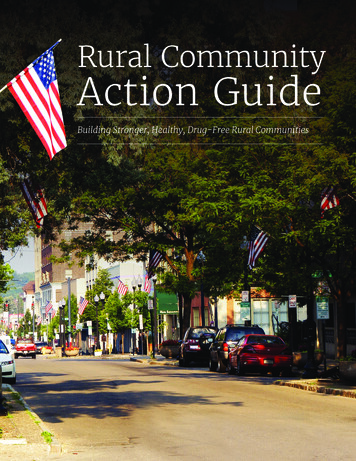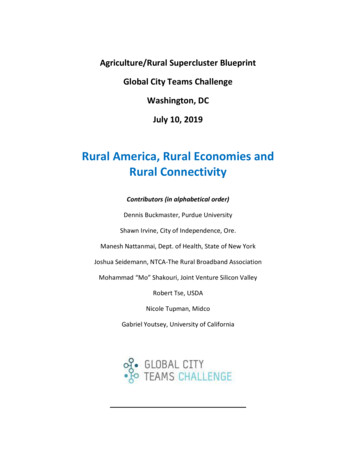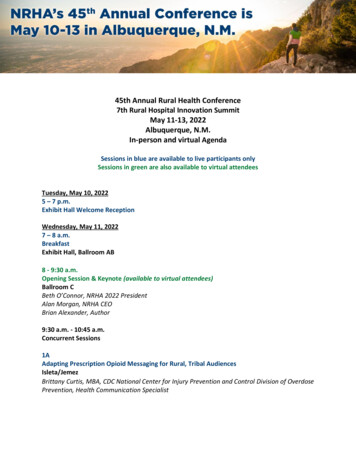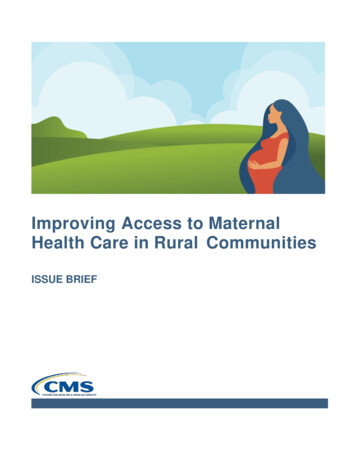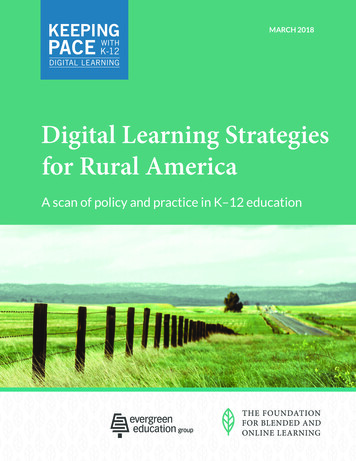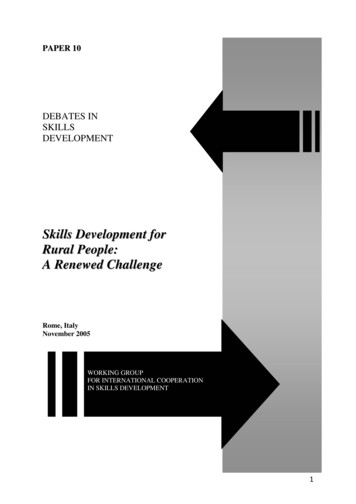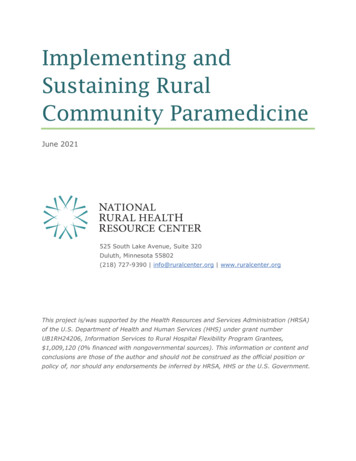
Transcription
Implementing andSustaining RuralCommunity ParamedicineJune 2021525 South Lake Avenue, Suite 320Duluth, Minnesota 55802(218) 727-9390 info@ruralcenter.org www.ruralcenter.orgThis project is/was supported by the Health Resources and Services Administration (HRSA)of the U.S. Department of Health and Human Services (HHS) under grant numberUB1RH24206, Information Services to Rural Hospital Flexibility Program Grantees, 1,009,120 (0% financed with nongovernmental sources). This information or content andconclusions are those of the author and should not be construed as the official position orpolicy of, nor should any endorsements be inferred by HRSA, HHS or the U.S. Government.
Prepared byandTami Lichtenberg, MAIndependent Consultanttlichten1515@gmail.comNATIONAL RURAL HEALTH RESOURCE CENTER1
Table of ContentsIntroduction . 4Executive Summary . 6Background . 7Community Paramedicine as an Emerging Model of Care . 8Mobile Integrated Health . 10Opportunities for Rural Community Paramedicine . 11Community Care Coordination . 11Potential New Funding Streams . 12Ability to Demonstrate Value . 13Challenges for Rural Community Paramedicine . 15Reimbursement and Funding Streams . 15Workforce Challenges . 16Leadership Challenges . 17Lack of Data Inhibits Ability to Show Value . 17Key Strategies for Community Paramedicine Implementation . 18Seek Partners Where You Can Make an Impact . 18Start the CP Program with a Narrow Focus . 18Show Value through Data and Outcomes . 19Ensure Patient Awareness and Vital Community Partnerships . 19Maximize COVID-19 Pandemic Flexibilities and Employ Telehealth WhenNeeded. 20Key Strategies for Sustainability . 21Plan Early for Sustainability . 21Focus on Data . 21Identify New and Continuous Funding Streams . 22Flex Program Support for the Implementation and Sustainment of RuralCommunity Paramedicine . 23Rural EMS Improvement Program Area of Flex . 23Acting as a Convener and Supporting Demonstration Projects . 24Conclusion . 26NATIONAL RURAL HEALTH RESOURCE CENTER2
References . 28Appendices . 30Appendix A: Established Models of Community Paramedicine . 31Appendix B: Key Community Paramedicine Resources Identified byParticipants . 32CP Curriculum . 32Evaluation Findings . 32Groups/Organizations/Projects . 33Presentations Highlighting CP Models. 33Protocols and Standards . 34Research/Policy Briefs . 34Tools and Resources . 36NATIONAL RURAL HEALTH RESOURCE CENTER3
IntroductionThe 2021 Rural Community Paramedicine Summit convened by the NationalRural Health Resource Center (The Center), with support from the HealthResources and Services Administration (HRSA), Federal Office of RuralHealth Policy (FORHP), was held in a virtual format on February 21-22,2021. The purpose of the meeting was to facilitate sharing of lessons learnedand key strategies related to the implementation and sustainment ofcommunity paramedicine (CP) in rural communities.One goal of this report is to share the experiences of established CPproviders with rural ambulance providers and hospitals so that they might bebetter prepared as they consider such initiatives in their own communities.The report is also intended to inform those that strive to improve the healthof rural communities, such as Medicare Rural Hospital Flexibility (Flex)Programs and State Offices of Rural Health, and to enable them to considerhow they might best support rural CP efforts through their programs.Meeting objectives included: Identify the challenges and opportunities related to theimplementation and sustainment of CP in rural communitiesIdentify established CP models and capture lessons learnedIdentify strategies and resources, both existing and needed, related tothe implementation and sustainment of rural CP, including how FlexPrograms can support related activitiesConsider the future of rural CPEstablish and disseminate a resource document summarizing theabove for rural health organizations to utilize in establishingcollaborative efforts to move towards value and population healthmodelsNATIONAL RURAL HEALTH RESOURCE CENTER4
Participants Joel Beiswenger, Tri-County Health Care, MinnesotaTahleah Chappel, Federal Office of Rural Health PolicyNicole Clement, National Rural Health Resource CenterSarah Craig, South Carolina State Office of Rural HealthJohn Gale, University of Southern Maine, Flex Monitoring TeamBritton Herbert, South Carolina Office of Rural HealthKiona Hermanson, National Rural Health Resource CenterTerry Hill, National Rural Health Resource CenterDanita Koehler, Alaskan Volunteer EMS Services in Southeast Alaskaand the Aleutian and Pribilof IslandsTami Lichtenberg, Independent ConsultantRobyn McArdle, North Carolina Office of Rural HealthKenneth Peach, Health Council of East FloridaKaren Pearson, University of Southern Maine, Flex Monitoring TeamJonah Thompson, Alleghany Health Network, PennsylvaniaGary Wingrove, The Paramedic Foundation (through follow-upconversation)Matt Zavadsky, MedStar Mobile Healthcare, National Association ofEmergency Medical Technicians (NAEMT)The information presented in this document is intended to provide thereader with a general guidance. The materials do not constitute and shouldnot be treated as professional advice regarding the use of any technique, orthe consequences associated with any technique. Every effort has beenmade to assure the accuracy of these materials. The Center and the authorsdo not assume responsibility for any individual's reliance upon the written ororal information provided in this guide. Readers and users shouldindependently verify all statements made before applying them to a situationand should independently determine the correctness of any planningtechnique before recommending the technique to a client or implementing iton a client's behalf.NATIONAL RURAL HEALTH RESOURCE CENTER5
Executive SummarySummit participants spent two half-days contemplating the past, present,and future of rural CP through presentations and small and large group workin which they addressed the objectives above.Key themes identified during the two days focused on lessons learned fromimplementation and opportunities to increase sustainability. Participantsidentified both opportunities and challenges for CP programs.Opportunities for rural CP programs: Community care coordination Potential new funding steams The ability to demonstrate valueChallenges for rural CP programs: Reimbursement and funding streamsWorkforce and leadership challengesThe lack of data inhibits the ability to show valueThe group also discussed key strategies for CP implementation that centeredaround: Seeking partners where you can make an impactStarting the CP program with a narrow focusShowing value through data and outcomesIdentifying vital community partnerships and ensuring patientawarenessMaximizing COVID-19 pandemic flexibilities and employing telehealthwhen neededThe summit participants also identified critical strategies for ensuringsustainability that included: Planning early for sustainabilityFocusing on dataIdentifying new and continuous funding streamsThe group then moved to ways that Flex Programs could act as a conveneror support CP programs through demonstration projects, assisting with stateor community assessments, and providing education and/or projects arounddata improvement.NATIONAL RURAL HEALTH RESOURCE CENTER6
Data and the ongoing need for it was a theme that resonated throughout thetwo-day summit and participants encouraged CP programs to look to othersuccessful models for consideration of measures while making sure to carveout their own path in the health care of their community.Participants agreed that CP has the ability to emerge as a critical partner inthe health of rural communities post-pandemic and can really benefit fromnew legislation and the flexibilities created by the public health emergency(PHE) to become a meaningful player in the new future of rural health care.With health care going through a sea of change, legislation such as theCARES Act and American Rescue Plan Act are allowing changes andflexibilities that never existed before and establishing a new role fortechnology. Emergency medical services (EMS) have tremendousopportunity to define and develop a new space for itself. As part of that newrole, CP has the ability to seize this moment, show its value, and embeditself in future solutions in Mobile Integrated Health.BackgroundAs the United States health care industry moves steadily toward value-basedpayment models and population health management, rural health careproviders are developing population health strategies that involve buildingpartnerships and systems to ensure that they meet the goals set by theCenters for Medicare and Medicaid Services (CMS), of better care, healthierpeople and communities, and smarter spending. Health care transformationprovides opportunities for rural EMS to be more fully integrated into thehealth care system as well as participate in new payment and collaborativecare models. The development of meaningful partnerships between thenation’s rural hospitals and their EMS providers and communities is crucial tosuccess in value-based care. A coordinated system of care has a crucial rolein health care transformation and has been identified as a strategy forreducing hospital readmissions by bridging the gaps between settings ofcare.Poised at the precipice of a new era in health care ushered in by ruralhospital closings, decreasing margins, a move to value-based health care,and sealed in fate by a global pandemic, all of health care has been forced torethink and re-imagine. According to the Rural Health Information Hub(RHIhub) topic guide, “CP is an emerging model that complements thetraditional roles of EMS providers, so they are partners in public health andcommunity health care delivery.” RHIhub also makes note that rural patientsNATIONAL RURAL HEALTH RESOURCE CENTER7
use 9-1-1 as their primary care, due to lack of access to other resources(Rural Health Information Hub, n.d.). This diverts critical resources andweighs down an already fragile EMS system. Community paramedicine canprovide access to both public health and primary care to provide access torural residents in a more appropriate way.Community Paramedicine as an EmergingModel of CareThe specific roles, focus, and services of CP initiatives vary from program toprogram and across states leading to many working CP definitions and titles.While there is no single definition, the National Association of EmergencyMedical Technicians (NAEMT) defines CP as, “One or more services providedby EMS agencies and practitioners that are administratively or clinicallyintegrated with other health care entities.” The Joint Committee on RuralEmergency Care (JCREC) describes a community paramedic as “ a statelicensed EMS professional that has completed an appropriate educationalprogram and has demonstrated competence in the provision of healtheducation, monitoring and services beyond the roles of traditionalemergency care and transport and in conjunction with medical direction.”The Flex Monitoring Team (a FORHP-funded consortium of researchers fromthe Universities of Minnesota, North Carolina-Chapel Hill, and SouthernMaine, funded to evaluate the impact of the Flex Program) released abriefing paper in 2014, The Evidence for Community Paramedicine in RuralAreas: State and Local Findings and the Role of the State Flex Program. Itdescribes two principal models of CP programming, both of which canaddress the needs of rural communities. Primary health care: Focuses on helping to prevent hospitalreadmissions (post-discharge care, chronic illness monitoring, andtargeting high-risk patients).Community Coordination: Works to connect patients to primary careand other social and medical services. (Pearson, Gale, Shaler, 2014).Community paramedicine is one way of filling gaps between care settingsand ensuring efficient transitions of care, not replacing other health careproviders. Some CP programs address both of the above-described needs.NATIONAL RURAL HEALTH RESOURCE CENTER8
A 2018 national survey from NAEMT states that, “Despite significant hurdlesto implementing and financially sustaining the programs, many EMSprofessionals embraced mobile integrated health-community paramedicine(MIH-CP) with enthusiasm.” The 2018 survey identified more than 200functioning programs in 33 states that met their definition of, “ fullyintegrated; collaborative; data-driven; patient-centered and team-based.”According to the survey document, insurance companies, managed careorganizations, and others are becoming more willing to pay for EMS toprovide such services and increasing numbers of EMS agencies are enteringinto such arrangements. The final report states, “Examples of MIH-CPactivities can include, but are not limited to, providing telephone adviceinstead of resource dispatch; providingchronic disease management,“CP can be the eyes, ears, andpreventive care or post-discharge followvoices of residents-- looking outup; or transport or referral to carefor problems and findingbeyond hospital emergencysolutions. With their help,departments.” (National Association ofresidents can have a consistent,Emergency Medical Technicians, 2018)convenient source of care fromexperts that not only know whatthey are doing but who carebecause they live in thecommunity too.”Outcomes in a CP program will vary buta reduction in unnecessary transportsto and reduced utilization of theEmergency Department (ED), costreduction, and effective referrals forGary Wingrove, The Paramedicpatient care may be measurableFoundationindicators of success. Less measurable,but as important, improvement in thequality of life for patients from reduction of hazards in the home, andimproved patient well-being. The respondents of the 2018 NAEMT studyrated their programs from 73 to 85 percent successful in different ways,including reduction of 30-day readmissions, 9-1-1 utilization reduction, andcost savings, to name a few. Eighty-five (85) percent rated their program ashighly or somewhat successful in achieving patient satisfaction. Untilrecently, rural EMS largely focused on emergency response to criticalsituations (National Association of Emergency Medical Technicians, 2018),but in rural areas where health care may be difficult to access and needsoutweigh providers, CP can take advantage of EMS professionals that havedown time between emergency calls and the skills and ability to providemuch needed health care services.NATIONAL RURAL HEALTH RESOURCE CENTER9
When not responding to emergencies, the CP professional is available to helpin additional manners such as managing chronic diseases as well asproviding immunizations and screenings. Likewise, they may be able tomonitor care and provide counseling regarding resources related to socialdeterminants of health and self-care.While the specific roles and services aredetermined by community and publichealth needs, in addition to medicaldirection, CP capitalizes on theuntapped resources of emergencymedical providers in rural communities.Community paramedicine professionalsexpand their skills and roles in order toprovide any number of services such asassessments, connections to primarycare, integration and care coordinationwith home health, immunizations, andchronic care support.“In its most basic form, CP is aprogram operated by an EMSservice that has aligned withothers. MIH is a programoperated by other than an EMSservice that has aligned withcommunity paramedics.”Gary Wingrove, The ParamedicFoundationAffectionately referred to as the “Swiss army knife” of health care by one ofthe summit participants, CP professionals are already recognized by thecommunity, skilled in assessment of critical needs, and comfortable workingwithin patients’ homes. With some additional training that supplements theiremergency medical skills, they have filled a crucial role in manycommunities.Mobile Integrated HealthThe term mobile integrated health care (MIH) is often incorrectly usedinterchangeably with CP, particularly outside of the EMS community. MIH isa broader concept, including health care services provided outside of ahealth care facility by any type of health professional, one example beingcommunity health workers (CHWs). To be inclusive, some organizations usethe term mobile integrated health care and community paramedicine (MIHCP).According to a vision statement from the NAEMT, “Mobile IntegratedHealthcare (MIH)–Community Paramedicine (CP) is the provision of healthcare using patient-centered, mobile resources in the out-of-hospitalenvironment. MIH is provided by a wide array of health care entities andNATIONAL RURAL HEALTH RESOURCE CENTER10
practitioners that are administratively or clinically integrated with EMSagencies, while CP is one or more services provided by EMS agencies andpractitioners that are administratively or clinically integrated with otherhealth care entities.”MIH-CP programs should be goal-oriented, patient-centered, collaborativeand team-based. An MIH-CP approach is all about triage and making surethe most appropriate resource is available.Opportunities for RuralCommunity ParamedicineSummit participants identified three broad areas of opportunity regarding CPimplementation and sustainability: Community care coordination Potential new funding streams Ability to demonstrate valueCommunity Care CoordinationCommunity paramedicine was identified as having the ability to provide afield version of case management or care coordination. Emergency medicalservices practitioners are already welcomed by the public into homes when apatient may be having the worst day of their life and are recognized ascaregivers. At the same time, CP is viewed as being able to enhance theskills of rural ambulance services and is potentially one way of turningvolunteers into full time staff. It was mentioned that advanced practice EMSprofessionals such as paramedics are not always necessary for carecoordination. Lower-level practitioners with some additional training could beused in a more systematic way to bridge gaps. “Paramedics” and“paramedicine” in the CP context are inclusive of Emergency MedicalTechnicians (EMT), Advanced EMTs, and paramedics.Opportunities for CP to provide care in the community include routine things,such as medication and home safety checks. As noted by one participant, 84percent of the patients that were seen in their CP medication check programrequired interventions from a pharmacist for such things as contraindications or medication review with the prescribing provider.NATIONAL RURAL HEALTH RESOURCE CENTER11
Participants also cited that CP could play a role in avoidable admissions andreducing hospital re-admissions by collaborating with home health posthospital discharge or communicating with a primary care physician. Inaddition, the ability to supplement or assist with telehealth visits such astele-psychiatry or tele-rehabilitation provides an avenue for CP to be part ofthe exponential growth of telehealth due to the COVID-19 pandemic. Manypatients will need different levels of assistance with these technologieswhether it be access to devices, broadband, or the technological skill, andcommunity paramedics can provide that assistance.“Organizations at financial riskare realizing that they are payingfor prevention and find thatvaluable.”Kenneth Peach, Health Council ofEast FloridaThe ability to affect social determinantsof health, clinical support as anextension of physician practice, supportnew health care disciplines such asdialysis and palliative care can providerural CP with many opportunities in thefuture to show value.Potential New Funding StreamsThe use of CP to support frontier and isolated communities was identified asan opportunity. Around the clock access using telehealth is beneficial if thereis not a sufficient population to sustain hospital and clinical care. Many ruralEMS services might be able to employ and pay staff if they were able to billfor services that were more consistent than emergency calls.Additional opportunities that capitalize on the needs of other health carepartners such as accountable care organizations (ACOs) were outlined. Oneparticipant spoke of their CP program partnering with an ACO to assist themin meeting their value-based care goals by providing a number of eye examsthat needed to be accomplished in a short amount of time. He cited anotherexample of the CP program entering into an agreement with a hospital totake on a patient with a high probability of readmission. For a set fee, the CPprogram saw the patient eight times, but it was still less costly than one EDvisit and hospital readmission was avoided. He cited a study about the 18top avoidable costs for same cause readmission that put the average cost ofreadmission at about 14,000 (Agency for Healthcare Research and Quality,2019).NATIONAL RURAL HEALTH RESOURCE CENTER12
The summit participants talked about the need to be innovative and stretchthe boundaries of current thinking, while being flexible, and test concepts.However, they pointed out that pilot programs should be advertised as suchso that everyone knows what is happening up front. Shared savings can becreated through transition care management. An already allowable servicefor payers, using CP to provide care management to patients transitioningfrom acute to post-acute settings could provide a much-needed revenuestream while helping hospitals to avoid readmissions. New models such asAcute Hospital Care at Home from CMS is bringing care into the home andsome hospitals are utilizing community paramedicine in these programs.There may also be the opportunity to engage with traditional state-based ormanaged Medicaid plans.The key, according to participantsoperating CP programs, is to be open toany opportunity - especially those that fillgaps while being able to show howoptimizing care integration can affect costbased reimbursement, and show value tothe community, health care partners, andpayers while not exceeding the currentcapacity of CP program staff.“EMS assumes its value to beinherent and that its worth isevident.”Jonah Thompson, AlleghenyHealth NetworkAbility to Demonstrate ValueAnother opportunity identified by the group was the ability of CP programsto show value and demonstrate cost savings. It was important to theparticipants that CP will be able to explain the value to both traditional andnon-traditional partners alike, but that CP would need help to convey valuethrough outcome measurements.There are two basic ways to show value to both partners and communities:data and storytelling. Both are useful at different times and in differentcontext, but participants felt that both are important. The participants alsonoted that it is a challenge for CP programs to identify data andcommunicate their outcomes, value, and impact.Demonstrating cost savings is not a traditional concept for EMS. As healthcare moves from fee-for-service to a more value-based and cost sharingsystem, showing the value of cost avoidance will be important. Direct costavoidance requires the agreement of the partner agencies (such as theNATIONAL RURAL HEALTH RESOURCE CENTER13
hospital) to share cost information. Another option can be to use nationallyavailable Medicare information, though this may be very conservative datathough due to Medicare not always paying the actual cost of the service,except for allowable costs in critical access hospitals (CAHs).To better show cost savings and value, two general cost-avoidance formulaswere developed by the MedStar Mobile Healthcare team in Fort Worth,Texas. The first formula is for avoiding the cost of transport due totreatment in place and the second is a formula for calculating when a CPprogram helps avoid a hospital readmission. Cost-savings is important tohealth care providers and their partners, but some of the most compellinginformation for communities comes from anecdotal information about thetransformation in care for their members. For examples of outcomemeasures that can be used to demonstrate cost savings and value, pleasesee Appendix B. Key Community Paramedicine Resources Identified byParticipants.Karen Pearson, from the University of Southern Maine Flex Monitoring Team,shared a couple of examples from their research where patient care waspositively affected by CP. The first example cited was a patient enrolled in aCP program that had a history of multiple chronic conditions resulting inrepeated visits to the ED. In the 12 months prior to enrollment in the CPprogram, this patient had been to the ED eight times (seven by ambulance),with one hospital admission. The patient’s primary care physician (PCP)referred her to the CP program, directing the community paramedicineprofessional to visit the patient on a weekly basis to help with medicationreconciliation. In the year following enrollment, the patient called 9-1-1 onlyfour times and had no hospital admissions, thus showing a 50 percentreduction in ambulance transports, and also importantly, a cost savings tothe EMS system.In the next example, one patient was a frequent user of the EMS system andhad been hospitalized over 70 times prior to enrolling in the CP program.Over the course of 45 days, the community paramedic, who performed dailyvisits, was able to keep this patient out of the ED and hospital for 18 days.At that time, there was an ambulance transport followed by a brief four-dayhospitalization. The patient was then seen at home for 11 more days beforean ED visit, that did not result in hospitalization, took place. Additionally, thepatient was seen in the ED for lab work, but not hospitalized. This patientdid not return to the ED or hospital during the remainder of this 45-dayperiod. (Pearson & Shaler, 2017)NATIONAL RURAL HEALTH RESOURCE CENTER14
Another summit participant, who runs a CP program based within a CAH,recounted a patient that was referred to their CP program with seriousmental health issues after multiple encounters with law enforcement.Through relationship building and addressing needs that encompassed manybasic social determinants of health, the community paramedic built trust andwas able to significantly impact the health of the patient. The CAH CEO latersaw the local sheriff who shared they were under the impression that theindividual must have moved out of the area because law enforcement had noencounters with the individual in recent months. The sheriff was astonishedto find out that the individual still lived in the community and the positiveeffect the CP program was having.Data and information can show cost savings in real dollars and is highlyimportant, but the actual stories of patients and care being affectedpositively defines the human impact of CP programs, which are important forpolicy governing boards and legislators to hear.Challenges for Rural CommunityParamedicineThis section contains information about the four main ideas participantsidentified: Reimbursement and funding streams Workforce challenges Leadership challenges Lack of data inhibits ability to show valueReimbursement and Funding StreamsReimbursement has always been a challenge for EMS. Largelymisunderstood, everyone expects the highest level of pre-hospital care to bea call away when needed, but most have no idea what level of care isprovided in their communities, what it costs, or how it is funded. Rural EMSworkforce consists mainly of services staffed by volunteers; these dedicatedindividuals are often responding to ambulance calls from their regular fulltime jobs. One national EMS expert has often said, “Where paramedics aremost needed, they are least found.”N
Implementing and Sustaining Rural Community Paramedicine June 2021 . 525 South Lake Avenue, Suite 320 Duluth, Minnesota 55802 (218) 727-9390 info@ruralcenter.org www.ruralcenter.org
